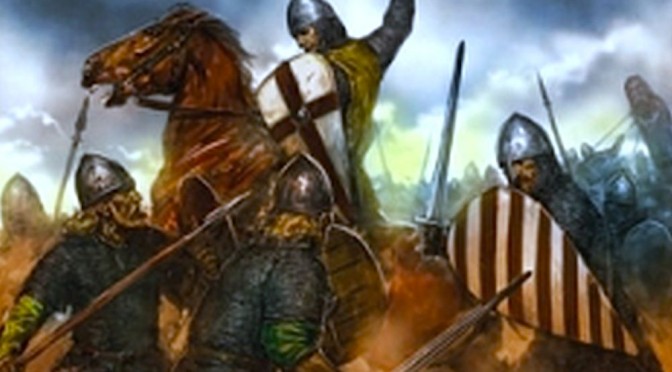Kill them all!
At the very start of the Albigensian Crusade in Beziers, when a soldier asked the Papal Legate how heretics could be distinguished from adherents to the Church of Rome, the legate answered:-“Kill them all, God will know his own”. We even know the name of the legate, Arnold Amaury.
There is little dispute about the conduct of the Albigensian crusade. We have access to both sides of the story and there is remarkable concurrence. From this it can be seen that the Roman Church felt no need to cover up or apologise for what occured. After the crusade they were in a position of strength and they were proud of what had been achieved.
The objective of the Crusade was declared to be the elimination of the Cathar faith, During the Crusade christian knights were given the same benefits as they would have received to fight the Saracens. It became a grab for land and soon turned into a genocidal war of the worst kind which lasted over fifty years, to be then followed by the horrors of the “Holy”Inquisition, which incidentally was founded in Occitan not in Spain.
In 1355 Ximene is still haunted by the possibility that her attempts to claim her inheritance might trigger a new crusade.
The council at St Felix
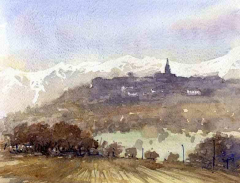 The Albigensian Crusade may well have been itself triggered by a meeting of alternative Church leaders from many different geographical locations. This was the only recorded council of the Cathar church and it was held in the small town of St Felix de Lauragais in 1167 AD. St Felix sits on a hill in the heart of the Val du Midi. Attendees were not just from Occitan but from Anjou, Lombardy,Constantinople, Flanders, Brittany, Germany and from the British Isles.
The Albigensian Crusade may well have been itself triggered by a meeting of alternative Church leaders from many different geographical locations. This was the only recorded council of the Cathar church and it was held in the small town of St Felix de Lauragais in 1167 AD. St Felix sits on a hill in the heart of the Val du Midi. Attendees were not just from Occitan but from Anjou, Lombardy,Constantinople, Flanders, Brittany, Germany and from the British Isles.
There for a brief moment the Cathars showed evidence of a unified structure, however informal. This gathering was attended amongst others, by Nicetas, leader of the Bogomil faith, which leads to speculation that Cartharism was linked or the same as Bogomolism and therefore linked to the Paulicans, and to Manichaeism. It is possible however that this was simply an ecumenical meeting to show solidarity against the Church of Rome. The Cathars did show tolerance for the beliefs of other faiths so the idea of an ecumenical gathering is not improbable.
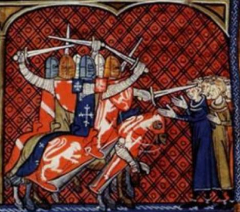 The Crusade took place 100 years ago. A measure of it's success is that it is still engraved in Cathar minds.The action taken by the Pope in response to this gathering was the launching of a crusade against the Cathars.
The Crusade took place 100 years ago. A measure of it's success is that it is still engraved in Cathar minds.The action taken by the Pope in response to this gathering was the launching of a crusade against the Cathars.
Different Priorities
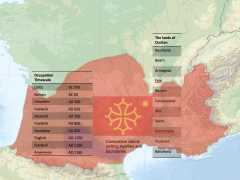 The ownership of the lands below the Loire and west of the Rhone was less well defined than anywhere else in Europe. Couple that fact with the prevalence of support for the Cathar faith in this area meant that there was always the potential for war. The Cathar faith itself because of it's condemnation of material issues contributed to the Southern Lord's lack of concern for feudal alliances and opposition to the trend to think in terms of national identities. They payed dearly for this. (See History/Aquitaine and Occitan for more information)
An alternative view is that the younger sons of northern lords were hungry for land, anyone's land. They were only searching for a way of legitimising their theft.In the early centuries of the second millenium, the ownership of the lands below the Loire and west of the Rhone was less well defined than anywhere else in Europe. When that fact is coupled with that fact that in this area there was a prevalence of support for the Cathar faith, there was always the potential for war.
The ownership of the lands below the Loire and west of the Rhone was less well defined than anywhere else in Europe. Couple that fact with the prevalence of support for the Cathar faith in this area meant that there was always the potential for war. The Cathar faith itself because of it's condemnation of material issues contributed to the Southern Lord's lack of concern for feudal alliances and opposition to the trend to think in terms of national identities. They payed dearly for this. (See History/Aquitaine and Occitan for more information)
An alternative view is that the younger sons of northern lords were hungry for land, anyone's land. They were only searching for a way of legitimising their theft.In the early centuries of the second millenium, the ownership of the lands below the Loire and west of the Rhone was less well defined than anywhere else in Europe. When that fact is coupled with that fact that in this area there was a prevalence of support for the Cathar faith, there was always the potential for war.
The Cathar faith itself, because of it’s condemnation of material issues, contributed to the Southern Lord’s lack of concern for feudal alliances. There was active opposition to the trends to think in terms of national identities, and group togerther for mutual advancement and defence. The Lords of the South payed dearly for this opposition.
The Racial Mix
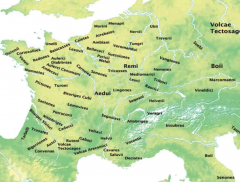 For a long period the whole of what we now call France was occupied by celtic tribes, whom Caesar called Gauls.
For a long period the whole of what we now call France was occupied by celtic tribes, whom Caesar called Gauls.
Roman conquest did little to displace these independent Tribes. The Celts took well to life under Roman rule. However as the Pax Romana unravelled there were a series of invasions and more importantly the movement of whole populations.
Clovis
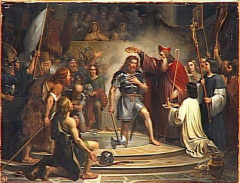 In 480 the Church of Rome chose Clovis, the teenage leader of an obscure Germanic tribe to be God’s appointed leader on earth. The Franks emerged from the marshes on the southern shores of the North (Germanic) sea and their speciallity up to that time had been piracy on the high seas. There are many legends and some outright lies told about the choice of Clovis. The main criteria seems to have been that he was prepared to submit to the authority of the Church of Rome . The Pope gave Clovis an immediate task eliminate all religions other that The Church of Rome.
In 480 the Church of Rome chose Clovis, the teenage leader of an obscure Germanic tribe to be God’s appointed leader on earth. The Franks emerged from the marshes on the southern shores of the North (Germanic) sea and their speciallity up to that time had been piracy on the high seas. There are many legends and some outright lies told about the choice of Clovis. The main criteria seems to have been that he was prepared to submit to the authority of the Church of Rome . The Pope gave Clovis an immediate task eliminate all religions other that The Church of Rome.
He invaded and defeated the Visigoths who had carved out an independant empire from the roman remnants in what is now southern France and Spain
In the period leading up to the 14th century, the Franks never won total control of the South. Partly this was due to the Frankish tradition of dividing possessions amongst eligible sons, partly due to fact that the Moors took control for a critical period. Partly that the people of the south spoke a different language which always made Franks foreigners. The result was that the southerners governed themselves and saw the Franks as largely irrelevant.
Feudal instability
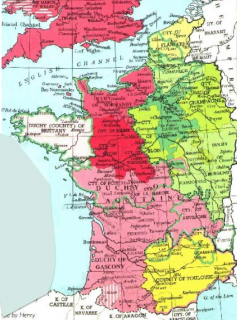 The Ramnulfid family became Dukes (Kings) of Aquitaine and in1200 their possessions were greater than the King of the Franks. They also had claim to toulouse but the Compte de Toulouse broke away and swore fealty to the Franks. This was dome when the duke of Aquitaine was away on a crusade, so in theory this action was against the laws of the Church of Rome. The Trencavels then broke away from their fealty to Toulouse. With the agreement of Richard the lionheart the swore fealty to AragonThere is real doubt as to wether Aquitaine including Occitan was a Dukedom or an Independant Kingdom.
The Ramnulfid family became Dukes (Kings) of Aquitaine and in1200 their possessions were greater than the King of the Franks. They also had claim to toulouse but the Compte de Toulouse broke away and swore fealty to the Franks. This was dome when the duke of Aquitaine was away on a crusade, so in theory this action was against the laws of the Church of Rome. The Trencavels then broke away from their fealty to Toulouse. With the agreement of Richard the lionheart the swore fealty to AragonThere is real doubt as to wether Aquitaine including Occitan was a Dukedom or an Independant Kingdom.
The Ramnulfid family became Dukes (Kings) of Aquitaine and in 1200 their possessions were far greater than the King of the Franks. They also had claim to Toulouse but the Compte de Toulouse broke away and swore fealty to the Franks. This separation was made when the duke of Aquitaine was away on a crusade. In theory this action was against the laws of the Church of Rome.
The Trencavel family then broke away from their fealty to Toulouse.
With the agreement of Richard the Lionheart, the Ramnulfid king, also known in england as “Plantagenet” the Trencavels then swore fealty to Aragon.
the Invasion
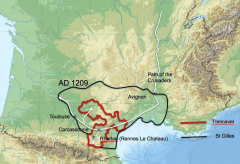 What occured was nothing short of horrific. The Compte of Toulouse was “persuaded” ( by the threat of excommunication reinforced by a public whipping) to stand to one side whilst the Crusaders attacked the Trencavel lands.
Brutality was used as a deliberate weapon to intimidate the populace and discredit their rulers.It was this breakaway which finally triggered action. Provence, Mergueil and Montpellier had already sworn allegiance to Aragon and it seemed possible that Toulouse would follow suit in the hope of regaining control of Trencavel.
What occured was nothing short of horrific. The Compte of Toulouse was “persuaded” ( by the threat of excommunication reinforced by a public whipping) to stand to one side whilst the Crusaders attacked the Trencavel lands.
Brutality was used as a deliberate weapon to intimidate the populace and discredit their rulers.It was this breakaway which finally triggered action. Provence, Mergueil and Montpellier had already sworn allegiance to Aragon and it seemed possible that Toulouse would follow suit in the hope of regaining control of Trencavel.
The reason the Pope organised the crusade was not territorial per se but the destruction of the Cathar faith which denied the validity of the Old Testament and criticised elaborate churches, vestments and ceremonials. He called the Cathars wicked heretics.
However the reason the King of the Franks supported the Crusade was to prevent a further expansion of Aragonese territory.
An alternative more cynical view is that the younger sons of northern lords were hungry for land, anyone’s land. They were only searching for a way of legitimising their theft.
The crusaders came down the Rhone valley to avoid having to fight their way through Ramnulfid territory. Even then the invasion route skirted the eastern edge of the Ramnulfid territory. Perhaps Papal authority was used to push a way through. It was extemely possible that another justification for the invasion was to attack the “soft underbelly of the Ramfulnids, to make it possible to attack them on two fronts.
The lands of the Trencavels were preferentially attacked. The switch of Trencavel allegiance to Aragon was undoubtably a factor in this decision.
The Trencavel’s disposessed
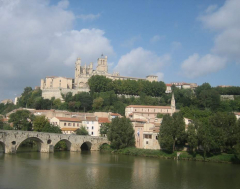 The crusaders massed outside Beziers.
They were expected to request that roman prelates be allowed to enter the city and convert the Cathars. Instead aided by an element of surprise they stormed the walls of the city. Twenty thousand; men, women and children, were put to the sword on that first day.What occured was nothing short of horrific. The Compte of Toulouse was “persuaded” ( by the threat of excommunication reinforced by a public whipping) to stand to one side whilst the Crusaders attacked the Trencavel lands.Brutality was used as a deliberate weapon to intimidate the populace and discredit their rulers.
The crusaders massed outside Beziers.
They were expected to request that roman prelates be allowed to enter the city and convert the Cathars. Instead aided by an element of surprise they stormed the walls of the city. Twenty thousand; men, women and children, were put to the sword on that first day.What occured was nothing short of horrific. The Compte of Toulouse was “persuaded” ( by the threat of excommunication reinforced by a public whipping) to stand to one side whilst the Crusaders attacked the Trencavel lands.Brutality was used as a deliberate weapon to intimidate the populace and discredit their rulers.
The crusaders massed outside Beziers.They were expected to request that roman prelates be allowed to enter the city and to attempt to convert the Cathars. Instead aided by an element of surprise they stormed the walls of the city. Twenty thousand; men women and children, were put to the sword on that first day.
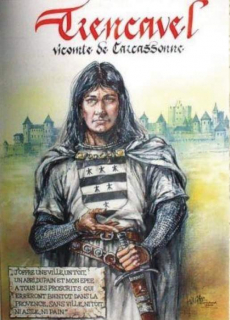 Raimond -Roger Trencavel declared “I offer a town, a roof, a shelter, bread and my sword to all the persecuted people who will soon be wandering in Provence without a town, a roof, a place of refuge, or bread.”This declaration was his death warrant.
Raimond -Roger Trencavel declared “I offer a town, a roof, a shelter, bread and my sword to all the persecuted people who will soon be wandering in Provence without a town, a roof, a place of refuge, or bread.”This declaration was his death warrant.
Treachery
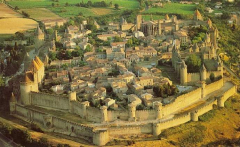 At Carcassonne the crusaders asked for a parley with Raimond-Roger. Trusting in the principles of chivalry he left the city to negotiate terms. He returned to the city as a prisoner and was put in chains in one of his own dungeons. Three months later he was dead. No charges were ever brought against him. An "unknown knight" called Simon de Monfort was given command of the crusader forces and assumed control of all the Trencavel lands. Simon was in fact by birth the Earl of Leicester but King John of England had confiscated his land because he had sworn allegiance to the King of the Franks. This might explain some of Simon's motivation.At Carcassonne the crusaders asked for a parley with Raimond-Roger. Trusting in the principles of chivalry he left the city to negotiate terms. He returned to the city as a prisoner and was put in chains in one of his own dungeons. Three months later he was dead. No charges were ever brought against him. An “unknown knight” called Simon de Monfort was given command of the crusader forces and assumed control of all the Trencavel lands. Simon was in fact by birth the Earl of Leicester but King John of England had confiscated his land because he had sworn allegiance to the King of the Franks. This might explain some of Simon’s motivation.
At Carcassonne the crusaders asked for a parley with Raimond-Roger. Trusting in the principles of chivalry he left the city to negotiate terms. He returned to the city as a prisoner and was put in chains in one of his own dungeons. Three months later he was dead. No charges were ever brought against him. An "unknown knight" called Simon de Monfort was given command of the crusader forces and assumed control of all the Trencavel lands. Simon was in fact by birth the Earl of Leicester but King John of England had confiscated his land because he had sworn allegiance to the King of the Franks. This might explain some of Simon's motivation.At Carcassonne the crusaders asked for a parley with Raimond-Roger. Trusting in the principles of chivalry he left the city to negotiate terms. He returned to the city as a prisoner and was put in chains in one of his own dungeons. Three months later he was dead. No charges were ever brought against him. An “unknown knight” called Simon de Monfort was given command of the crusader forces and assumed control of all the Trencavel lands. Simon was in fact by birth the Earl of Leicester but King John of England had confiscated his land because he had sworn allegiance to the King of the Franks. This might explain some of Simon’s motivation.
Caberet
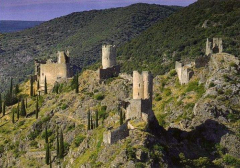 Many small towns very taken easily but a short distance from Carcassonne was the mountain fortress of Caberet. The fortress, above the town of Lastours consisted of three separate towers positioned so that besigers of one tower could be attacked from the other two. The Crusaders tried to capture Caberet but failed. Frustrated by this failure, a warning was sent to Caberet. One hundred inhabitants from the town of Bram were blinded and their noses and top lips were cut off. one of them was left with one eye so he could lead the others to "refuge" at Cabaret. The ghastly procession painfully made its way up the slopes of the mountain each one guided by holding on to the shoulders of the one in front.Many small towns very taken easily but a short distance from Carcassonne was the mountain fortress of Caberet. The fortress, above the town of Lastours consisted of three separate towers positioned so that besigers of one tower could be attacked from the other two. The Crusaders tried to capture Caberet but failed. Frustrated by this failure, a warning was sent to Caberet. One hundred inhabitants from the town of Bram were blinded and their noses and top lips were cut off. one of them was left with one eye so he could lead the others to “refuge” at Cabaret. The ghastly procession painfully made its way up the slopes of the mountain each one guided by holdin on to the shoulders of the one in front.
Many small towns very taken easily but a short distance from Carcassonne was the mountain fortress of Caberet. The fortress, above the town of Lastours consisted of three separate towers positioned so that besigers of one tower could be attacked from the other two. The Crusaders tried to capture Caberet but failed. Frustrated by this failure, a warning was sent to Caberet. One hundred inhabitants from the town of Bram were blinded and their noses and top lips were cut off. one of them was left with one eye so he could lead the others to "refuge" at Cabaret. The ghastly procession painfully made its way up the slopes of the mountain each one guided by holding on to the shoulders of the one in front.Many small towns very taken easily but a short distance from Carcassonne was the mountain fortress of Caberet. The fortress, above the town of Lastours consisted of three separate towers positioned so that besigers of one tower could be attacked from the other two. The Crusaders tried to capture Caberet but failed. Frustrated by this failure, a warning was sent to Caberet. One hundred inhabitants from the town of Bram were blinded and their noses and top lips were cut off. one of them was left with one eye so he could lead the others to “refuge” at Cabaret. The ghastly procession painfully made its way up the slopes of the mountain each one guided by holdin on to the shoulders of the one in front.
Minerve
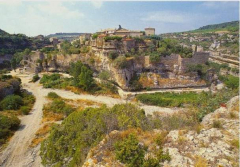 The crusaders turned their attention to the fortress town of Minerve. The town was captured was captured and one hundred and forty Cathar Perfects were burned at the stake.The crusaders turned their attention to the fortress town of Minerve. The town was captured was captured and one hundred and forty Cathar Perfects were burned at the stake.
The crusaders turned their attention to the fortress town of Minerve. The town was captured was captured and one hundred and forty Cathar Perfects were burned at the stake.The crusaders turned their attention to the fortress town of Minerve. The town was captured was captured and one hundred and forty Cathar Perfects were burned at the stake.
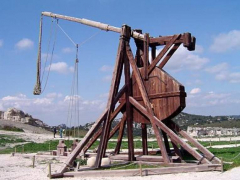 The Capture of Minerve was only possible because of the use of the formidable Trebuchet siege machines.
The key was the destruction of a fortified stairwell leading to the river, which the inhabitants used to keep themselves supplied with fresh water.
A Trebuchet hurled hugh stones with extreme accuracy.The Capture of Minerve was only possible because of the use of the formidable Trebuchet siege machines.
The Capture of Minerve was only possible because of the use of the formidable Trebuchet siege machines.
The key was the destruction of a fortified stairwell leading to the river, which the inhabitants used to keep themselves supplied with fresh water.
A Trebuchet hurled hugh stones with extreme accuracy.The Capture of Minerve was only possible because of the use of the formidable Trebuchet siege machines.The key was the destruction of a fortified stairwell leading to the river, which the inhabitants used to keep themselves supplied with fresh water.
A trebuchet hurled hugh stones with extreme accuracy.
Lavaur
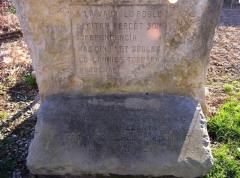 The crusaders then turned on the Compte de Toulouse. They pursued a relatively narrow path up the Garronne valley to the edge of English territory in Aquitaine. Only then did they set about the serious task of consolidating their hold on Trencavel lands.
When the crusaders attacked Lavaur , inside the territory of the Compte de Toulouse, over four hundred perfects were burned and Gerelda de Montreal, the chatelaine of Lavaur, was first thrown down a well and then stoned to death.The crusaders then turned on the Compte de Toulouse. They pursued a relatively narrow path up the Garronne valley to the edge of English territory in Aquitaine. Only then did they set about the serious task of consolidating their hold on Trencavel lands. When the crusaders attacked Lavaur, inside the territory of the Compte de Toulouse, over four hundred perfects were burned and Gerelda de Montreal, the chatelaine of Lavaur, was first thrown down a well and then stoned to death.
The crusaders then turned on the Compte de Toulouse. They pursued a relatively narrow path up the Garronne valley to the edge of English territory in Aquitaine. Only then did they set about the serious task of consolidating their hold on Trencavel lands.
When the crusaders attacked Lavaur , inside the territory of the Compte de Toulouse, over four hundred perfects were burned and Gerelda de Montreal, the chatelaine of Lavaur, was first thrown down a well and then stoned to death.The crusaders then turned on the Compte de Toulouse. They pursued a relatively narrow path up the Garronne valley to the edge of English territory in Aquitaine. Only then did they set about the serious task of consolidating their hold on Trencavel lands. When the crusaders attacked Lavaur, inside the territory of the Compte de Toulouse, over four hundred perfects were burned and Gerelda de Montreal, the chatelaine of Lavaur, was first thrown down a well and then stoned to death.
Muret
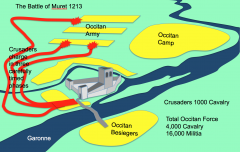 Finally the lords of Occitan, as one swore allegiance to Pedro of Aragon and put together a substantial albeit inexperience army. They trapped the Crusaders at Muret. Muret was one of the most significant battles ever fought. Incredibly the crusaders won, although hopelessly outnumbered. If the crusaders had been defeated in this battle it would have redrawn the map and the religious establishment of Western Europe. It would have meant more than the defeat of the crusaders, it would have meant the confirmation of Occitan as an independant state in an Aragonese empire.Finally the lords of Occitan, as one,swore allegiance to Pedro of Aragon and put together a substantial albeit inexperienced army. They trapped the Crusaders at Muret. Muret was one of the most significant battles ever fought. Incredibly the crusaders won, although hopelessly outnumbered. If the crusaders had been defeated in this battle it would have redrawn the map and the religious establishment of Western Europe. It would have meant more than the defeat of the crusaders, it would have meant the confirmation of Occitan as an independant state in an Aragonese empire.
Finally the lords of Occitan, as one swore allegiance to Pedro of Aragon and put together a substantial albeit inexperience army. They trapped the Crusaders at Muret. Muret was one of the most significant battles ever fought. Incredibly the crusaders won, although hopelessly outnumbered. If the crusaders had been defeated in this battle it would have redrawn the map and the religious establishment of Western Europe. It would have meant more than the defeat of the crusaders, it would have meant the confirmation of Occitan as an independant state in an Aragonese empire.Finally the lords of Occitan, as one,swore allegiance to Pedro of Aragon and put together a substantial albeit inexperienced army. They trapped the Crusaders at Muret. Muret was one of the most significant battles ever fought. Incredibly the crusaders won, although hopelessly outnumbered. If the crusaders had been defeated in this battle it would have redrawn the map and the religious establishment of Western Europe. It would have meant more than the defeat of the crusaders, it would have meant the confirmation of Occitan as an independant state in an Aragonese empire.
Recovery
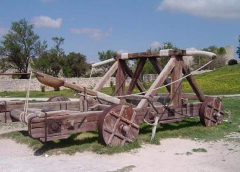 In the years which followed there were outbreaks of resistance. The hatred show by the local populace had an effect on the Crusaders. their numbers dwindled as did their hold on Occitan. The crusaders then moved to attack Toulouse itself were the resistance was strongest. In the midst of an extended siege, a mangonel, manned by women, threw a stone which killed Simon de Montfort.In the years which followed there were outbreaks of resistance. The hatred shown by the local populace had an effect on the Crusaders. Their numbers dwindled as did their hold on Occitan. The crusaders then moved to attack Toulouse itself where the resistance was strongest. In the midst of an extended siege, a mangonel, manned by women, threw a stone which killed Simon de Montfort.
In the years which followed there were outbreaks of resistance. The hatred show by the local populace had an effect on the Crusaders. their numbers dwindled as did their hold on Occitan. The crusaders then moved to attack Toulouse itself were the resistance was strongest. In the midst of an extended siege, a mangonel, manned by women, threw a stone which killed Simon de Montfort.In the years which followed there were outbreaks of resistance. The hatred shown by the local populace had an effect on the Crusaders. Their numbers dwindled as did their hold on Occitan. The crusaders then moved to attack Toulouse itself where the resistance was strongest. In the midst of an extended siege, a mangonel, manned by women, threw a stone which killed Simon de Montfort.
Marmande
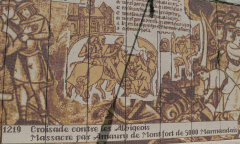 For the next two years the Crusaders roamed the country side murdering at will anyone who they suspected of heresy or who failed to provide the crusaders with whole hearted support. Crops were burned, fruit trees chopped down, vines ripped out and wells poisoned to "convert" dissident populations.
Simond's son Aumery lead an attack on Marmande, an English town founded by Richard the Lion Heart”. This attack has always been considered a mystery. It is not a mystery if considered in terms of demonstrating the opening of a second front from which it would be possible to attack English possessions. It was also a negotiation ploy by the De Montfort family. In the years shortly after Marmand, Simon de Monfort's younger son (also called Simon) was confirmed as the Earl of Liecester and made Seneshal of Gascony, thereby ensuring that there would be no attack on Aumery from English territory. In turn Aumery made no further attacks on English territory.( Simon Jr's image is in a position of prominence in the United States House of Representatives, credited as the father of democracy)For the next two years the Crusaders roamed the country side murdering at will anyone who they suspected of heresy or who failed to provide the crusaders with whole hearted support. Crops were burned, fruit trees chopped down, vines ripped out and wells poisoned to “convert” dissident populations.
For the next two years the Crusaders roamed the country side murdering at will anyone who they suspected of heresy or who failed to provide the crusaders with whole hearted support. Crops were burned, fruit trees chopped down, vines ripped out and wells poisoned to "convert" dissident populations.
Simond's son Aumery lead an attack on Marmande, an English town founded by Richard the Lion Heart”. This attack has always been considered a mystery. It is not a mystery if considered in terms of demonstrating the opening of a second front from which it would be possible to attack English possessions. It was also a negotiation ploy by the De Montfort family. In the years shortly after Marmand, Simon de Monfort's younger son (also called Simon) was confirmed as the Earl of Liecester and made Seneshal of Gascony, thereby ensuring that there would be no attack on Aumery from English territory. In turn Aumery made no further attacks on English territory.( Simon Jr's image is in a position of prominence in the United States House of Representatives, credited as the father of democracy)For the next two years the Crusaders roamed the country side murdering at will anyone who they suspected of heresy or who failed to provide the crusaders with whole hearted support. Crops were burned, fruit trees chopped down, vines ripped out and wells poisoned to “convert” dissident populations.
Simond’s son Aumery lead an attack on Marmande, an English town founded by Richard the Lion Heart. This attack has always been considered a mystery.
It is not a mystery if considered in terms of demonstrating the opening of a second front from which it would be possible to attack Ramnulfid possessions.
It was also a negotiation ploy by the De Montfort family. In the years shortly after Marmand, Simon de Monfort’s younger son (also called Simon) was confirmed as the Earl of Liecester and made Seneshal of Gascony, thereby ensuring that there would be no attack on Aumery from English territory. In turn Aumery made no further attacks on English territory.( Simon Jr’s image is in a position of prominence in the United States House of Representatives, credited as the father of democracy)
Victory for Occitan
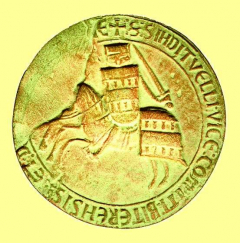 From 1220 to 1223 the revolt against the crusaders gained strength. The crusade ended in 1223 when Aumery de Montfort, finally beaten, abandoned his possessions in Occitan.
His last recorded act was to bequeath all of the St Gilles and Trencavel lands to the King of the Franks. The act was on all counts invalid but it gave the Franks the excuse to destroy Occitan. They terrorised the population infrequently but still did enough damage to reduce Occitan to penury. Critically in 1240 the grandson of Raimond Roger failed to retake Carcasonne, He surrendered and his seal as Viccompte was ceremonially broken.From 1220 to 1223 the revolt against the crusaders gained strength. The crusade ended in 1223 when Aumery de Montfort, finally beaten, abandoned his possessions in Occitan. His last recorded act was to bequeath all of the St Gilles and Trencavel lands to the King of the Franks. The act was on all counts invalid but it gave the franks the excuse to destroy Occitan. They terrorised the population infrequently but still did enough damage to reduce Occitan to penury. Critically in 1240 the grandson of Raimond Roger failed to retake Carcasonne, He surrendered and his seal as Viccompte was ceremonially broken.
From 1220 to 1223 the revolt against the crusaders gained strength. The crusade ended in 1223 when Aumery de Montfort, finally beaten, abandoned his possessions in Occitan.
His last recorded act was to bequeath all of the St Gilles and Trencavel lands to the King of the Franks. The act was on all counts invalid but it gave the Franks the excuse to destroy Occitan. They terrorised the population infrequently but still did enough damage to reduce Occitan to penury. Critically in 1240 the grandson of Raimond Roger failed to retake Carcasonne, He surrendered and his seal as Viccompte was ceremonially broken.From 1220 to 1223 the revolt against the crusaders gained strength. The crusade ended in 1223 when Aumery de Montfort, finally beaten, abandoned his possessions in Occitan. His last recorded act was to bequeath all of the St Gilles and Trencavel lands to the King of the Franks. The act was on all counts invalid but it gave the franks the excuse to destroy Occitan. They terrorised the population infrequently but still did enough damage to reduce Occitan to penury. Critically in 1240 the grandson of Raimond Roger failed to retake Carcasonne, He surrendered and his seal as Viccompte was ceremonially broken.
The retreat
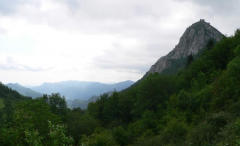 The Cathars now retreated to a series of mountain strongholds of which the most important was Monsegur.
In the absence of permanent occupation by the Franks the Cathar faith continued supported by the strongholds.The Cathars now retreated to a series of mountain strongholds of which the most important was Monsegur.In the absence of permanent occupation by the Franks the Cathar faith continued throughout Occitan, supported and sustained from the strongholds.
The Cathars now retreated to a series of mountain strongholds of which the most important was Monsegur.
In the absence of permanent occupation by the Franks the Cathar faith continued supported by the strongholds.The Cathars now retreated to a series of mountain strongholds of which the most important was Monsegur.In the absence of permanent occupation by the Franks the Cathar faith continued throughout Occitan, supported and sustained from the strongholds.
Montsegur
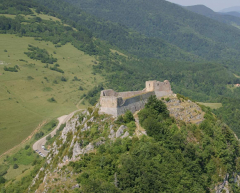 In 1243 the Franks decided that Monsegur must be eliminated. The preparations for the siege,and the siege itself took a full twelve months. In the end a decision was made to scale a sheer rock face and winch the component parts of a trebuchet to the end of a high ridge just below the chateau.
The Cathars surrendered and another two hundred and twenty of them were consigned to the flames.In 1243 the Franks decided that Monsegur must be eliminated. The preparations for the siege,and the siege itself took a full twelve months. In the end a decision was made to scale a sheer rock face and winch the component parts of a trebuchet to the end of a high ridge just below the Château. The Cathars surrendered and another two hundred and twenty of them were consigned to the flames.
In 1243 the Franks decided that Monsegur must be eliminated. The preparations for the siege,and the siege itself took a full twelve months. In the end a decision was made to scale a sheer rock face and winch the component parts of a trebuchet to the end of a high ridge just below the chateau.
The Cathars surrendered and another two hundred and twenty of them were consigned to the flames.In 1243 the Franks decided that Monsegur must be eliminated. The preparations for the siege,and the siege itself took a full twelve months. In the end a decision was made to scale a sheer rock face and winch the component parts of a trebuchet to the end of a high ridge just below the Château. The Cathars surrendered and another two hundred and twenty of them were consigned to the flames.
Queribus
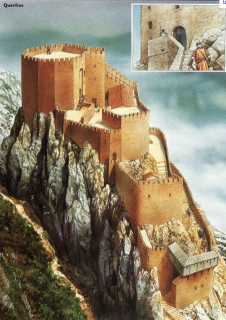 The final fortress was Queribus, visible on the crest of the Northern Pyrenees (from the road west from Perpignan travelling towards Quillian). Though it was subjected to siege it was never taken. One night the Cathar garrison simply vanished, bound for an unknown destination. The remaining Cathars went underground forming secret societies and independant cells to protect themselves against a new horror–The Holy Inquisition.The final fortress was Queribus, still visible on the crest of the Northern Pyrenees (from the road west from Perpignan travelling towards Quillian). Though it was subjected to siege it was never taken. One night the Cathar garrison simply vanished, bound for an unknown destination. The remaining Cathars went underground forming secret societies and independant cells to protect themselves against a new horror–The Holy Inquisition.
The final fortress was Queribus, visible on the crest of the Northern Pyrenees (from the road west from Perpignan travelling towards Quillian). Though it was subjected to siege it was never taken. One night the Cathar garrison simply vanished, bound for an unknown destination. The remaining Cathars went underground forming secret societies and independant cells to protect themselves against a new horror–The Holy Inquisition.The final fortress was Queribus, still visible on the crest of the Northern Pyrenees (from the road west from Perpignan travelling towards Quillian). Though it was subjected to siege it was never taken. One night the Cathar garrison simply vanished, bound for an unknown destination. The remaining Cathars went underground forming secret societies and independant cells to protect themselves against a new horror–The Holy Inquisition.
The perfect heresy
Authors Note:- Almost everything I know about the Albigensian Crusade has been covered in detail in a wonderful book called “The Perfect Heresy” by Steven o’Reilly. I notice from the cover that Lord Norwich recommends it as ” the ideal introduction to the story”. I think it is a bit more than that!
http://www.amazon.co.uk/Perfect-Heresy-Life-Death-Cathars/dp/1861973500
